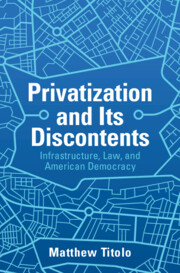Book contents
- Privatization and Its Discontents
- Privatization and Its Discontents
- Copyright page
- Dedication
- Contents
- Acknowledgments
- Introduction
- 1 Early Liberalism, Adam Smith, and the Seeds of the Infrastructural State
- 2 Forging the Infrastructural State
- 3 “A Wilderness of Turnpike Gates”
- 4 The Panic of 1837 and the Infrastructure Crash
- 5 “The Ground under Our Feet”
- 6 The Death of Laissez-Faire and the Rise of Infrastructure in the Cold War
- Conclusion
- Index
6 - The Death of Laissez-Faire and the Rise of Infrastructure in the Cold War
Published online by Cambridge University Press: 08 June 2023
- Privatization and Its Discontents
- Privatization and Its Discontents
- Copyright page
- Dedication
- Contents
- Acknowledgments
- Introduction
- 1 Early Liberalism, Adam Smith, and the Seeds of the Infrastructural State
- 2 Forging the Infrastructural State
- 3 “A Wilderness of Turnpike Gates”
- 4 The Panic of 1837 and the Infrastructure Crash
- 5 “The Ground under Our Feet”
- 6 The Death of Laissez-Faire and the Rise of Infrastructure in the Cold War
- Conclusion
- Index
Summary
The scale of the Great Depression and the obvious need for federal intervention mooted laissez-faire arguments. Nevertheless, the continuing vitality of laissez-faire sparked debates in law, economics, and public policy about the proper role of government that, in important ways, continue to the present. The chapter locates the rise of infrastructure as a common term within modernization theory and development economics, which provide the post-World War II with a western-centered model of capitalist growth. Modernization theory drew on social science, economics, and political theory to map society and economy as reciprocal systems that were amenable to policy intervention. Infrastructure” begins to circulate in the early 1950s as a novel concept among staffers at the World Bank and later in Congressional debates over the Marshall Plan. It first takes on a narrow meaning of military facilities and the resources that supported those facilities. From there, it becomes a portable concept that development economists could use to predict the “take off” or stagnation of emerging societies measured by rates of growth, GDP, social stability, and technological advance. We see our contemporary sense of infrastructure crystallize in the 1950s and 1960s as the material precondition for a flourishing modern capitalist democracy.
Keywords
- Type
- Chapter
- Information
- Privatization and Its DiscontentsInfrastructure, Law, and American Democracy, pp. 169 - 198Publisher: Cambridge University PressPrint publication year: 2023

